The skiing season has started and the Skull Canyon Ski Resort has re-opened. Join skiers and snowboarders from all over the world in being the first to travel ski runs with names like Black Magic, Fortress, Gold Spike, Whiskey Jack, and Sunshine Express. Over the course of 3 days you’ll collect Slope cards and use them to ski these runs and earn points, fame, and XXX, all while avoiding the yeti who lies in wait. After the day is over, head to the lodge for evening activities where you’ll earn valuable upgrades and find out what the next day has in store.
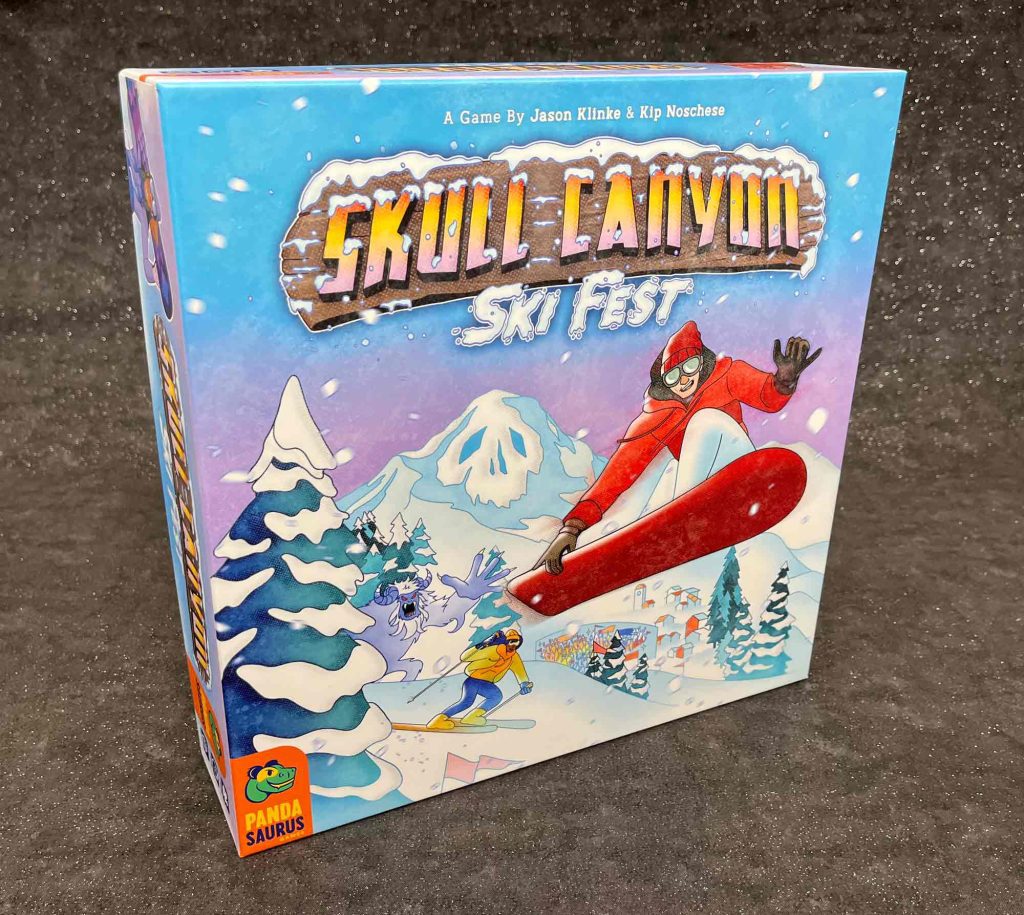
Skull Canyon Ski Fest Game Overview
In Skull Canyon Ski Fest, 2-4 players compete to have the most points at the end of 3 days. You’ll move your player piece around the board: upwards by traveling on the red ski lift routes, and downwards by way of the color coded “run” routes (green, blue, black; each with increasing difficulty). The higher the difficulty, the harder it is to complete, but the more points and fame you’ll receive.
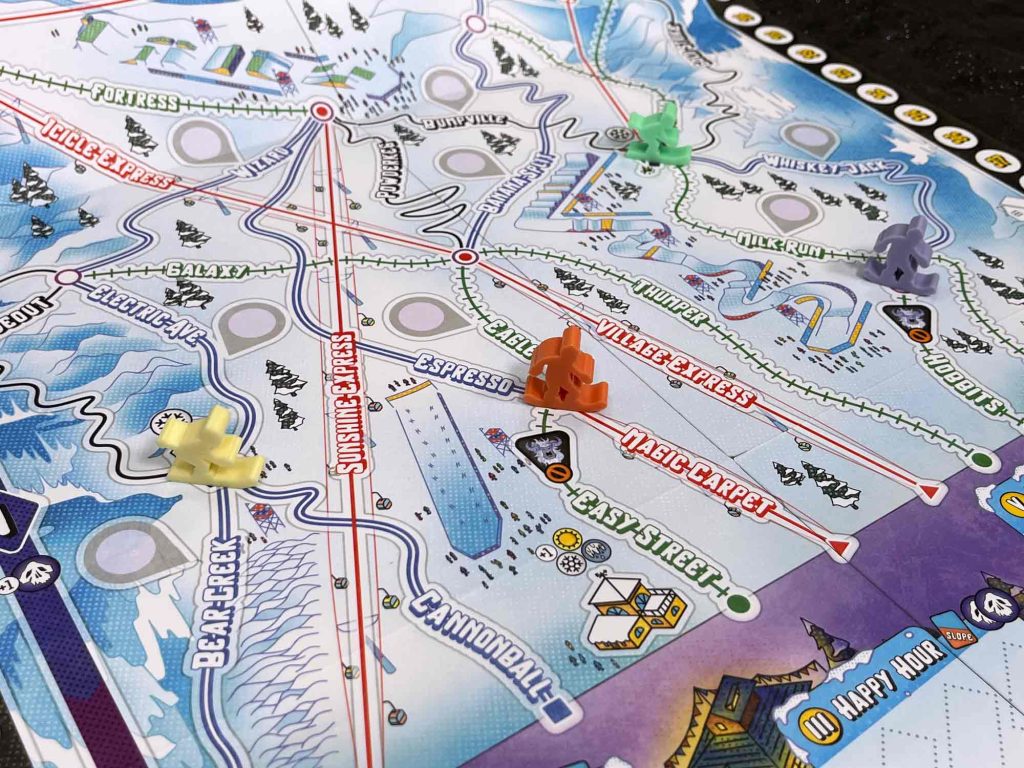
Phase 1: Skiing
On your turn, you can perform one of three actions
- Take slope cards – Take any two face up Slope cards from the public display, or from the face down draw pile.
- Ride a ski lift – Move upwards on any red ski lift route connected to your pawn’s current location.
- Ski a run – Play a set of cards from your hand to move downwards on a run connected to your pawn’s current location.
Runs are accomplished by playing Slope cards from your hand. Each colored run requires a minimum number of cards in order to travel the route. The easy green route only needs 2 cards, while the expert black route asks for 7 cards. In order to play Slope cards from your hand they must match in one of two ways: color (red, yellow, blue) or style (slopestyle, slalom, ski cross, moguls, off-piste). There are also a number of Yeti cards which are wild. If a player plays a set of cards containing a Yeti they must move the Yeti marker to block off a route, preventing any player from traveling that route until the Yeti is moved again. If a set is played with 2 or more Yeti cards, an avalanche is triggered and all players must move down one route (without earning points).
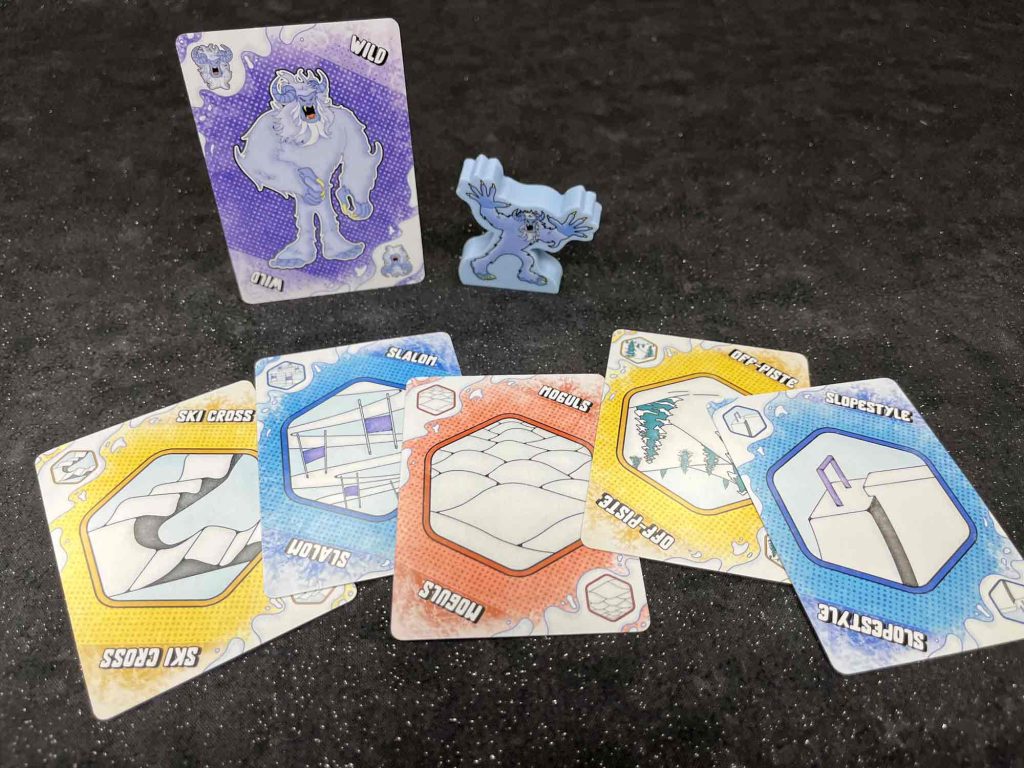
The first person to run each route gets to place a token of their color onto the separate route board. At the end of the game, players who have the majority of routes in each color receive bonus points, as does the person who has the most overall routes. When taking a route, you can always choose to pay the minimum amount of cards, but if you’re able to pay the route cost, plus additional cards based on the number of players who have previously claimed that route then you get to place your marker on top of the stack: claiming it for yourself, and making it that much harder for the next person to steal it from you.
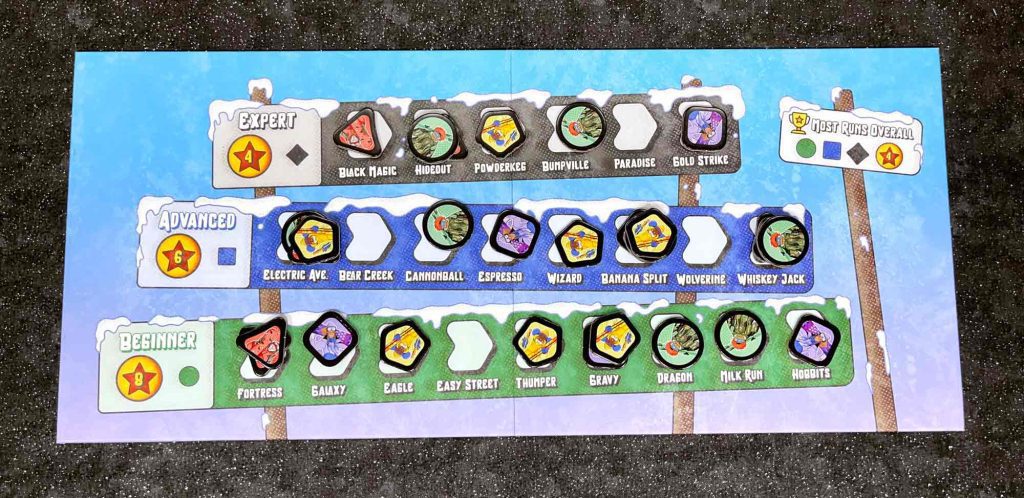
Runs will earn you points (which help you win the game) and fame (which is used as a currency in the evening phase of the day). Each of the blue and black routes have a randomly selected style bonus marker associated with it. When playing cards for this route, if all your cards are the same style as the bonus marker, your fame will be doubled.
After each round of play (or day) during phase 1, the Daylight track marker is moved down 1 step. Every day players will have 4 rounds on the mountain, and a final round in the ski lodge.
Phase 2: Après-Ski
At the end of the 4th round on the slopes, players will do their best to arrive at the bottom of the mountain. The player closest to the bottom, or furthest to the left on the bottom of the mountain, will have first choice of locations in the ski lodge.

In player order, each person will move their skier to the furthest left spot on the location of the ski lodge they want to visit. This is a blocking move and future players must hope they have a chance to take a space in that location as well (should they want it). Each location provides valuable bonuses such as gaining fame, receiving additional Slope cards, a free ski-lift token (good for one free move up the mountain), or even bomb tokens which can be used to trigger an avalanche. Each of these locations requires some form of payment (either cards, fame, or both) and if players can’t afford to pay the fee (or choose not to) then can always move to the hotel space and purchase gear cards.

Gear cards are worth points at game’s end and also grant rule-breaking special abilities ranging from being able to move up a ski route, paying fewer cards on specific colored routes, or receiving additional fame when skiing a run.
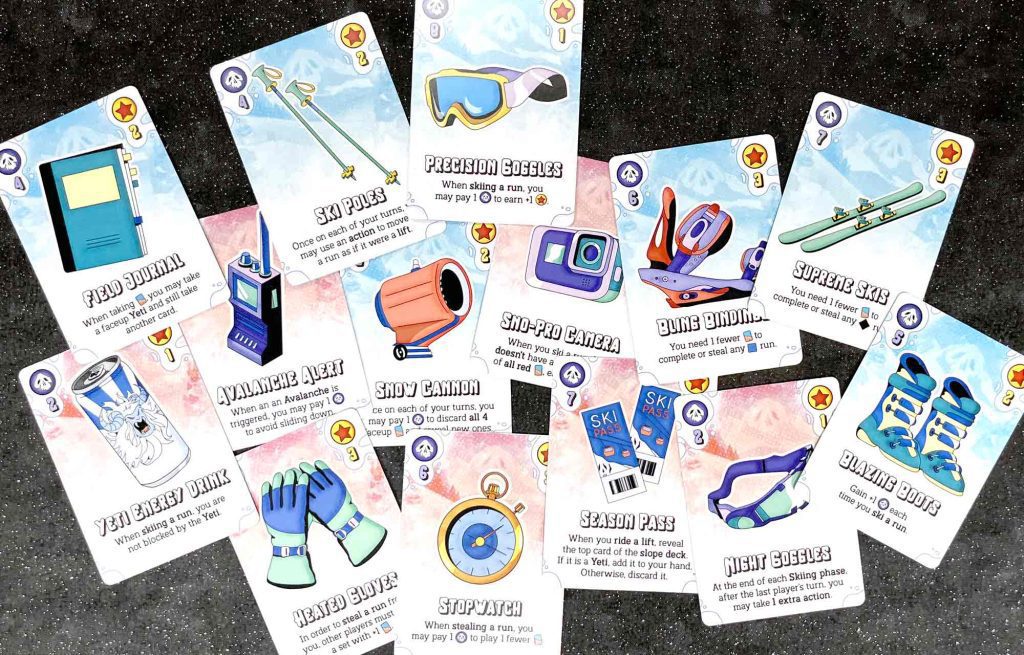
The player in the left-most space of the left-most location gets to move first and may move ahead to the next open space, potentially leap-frogging other players. Once all players have arrived at the hotel the round ends and the next day begins. After the last round, players skip the Apres-Ski phase and move straight to end game scoring.
Tally leftover fame (1 point per 3 fame), points from gear cards, and control over routes, and the player with the most points wins the game!
Skull Canyon Ski Fest Final Thoughts
I can still remember finding out about Skull Canyon Ski Fest at PAX Unplugged in 2021. The statement “It’s a bit like Ticket to Ride…mixed with a few other elements” is what caught my attention. You might know that we love Ticket to Ride, so anything that has the same vibe gets moved to the head of the line. After receiving a review copy earlier this year I immediately brought it out at my next game night, to great success.
Overall I’d say Skull Canyon Ski Fest gets a B+. The art is unique, the gameplay is smooth and interesting, and it has some real tension from the route claiming. Thinking back to my first introduction to the game, I think the similarities to Ticket to Ride are valid. Because players need to collect Slope cards in order to claim routes, there’s a constant balance between making sure you have enough cards (and the “right” ones), putting yourself into the correct position to ski down a run, and trying to get there before someone else puts their marker down. With a minimum of 7 cards, the black routes are hard enough to claim, but adding a 2nd or 3rd extra card to knock someone else off the top spot is tricky.
Our group also really enjoyed the worker placement aspect which takes place during the Apres-Ski phase of the day. While arriving first does ensure you get first chance at a prime location, it can also mean that you miss out on locations closer to the hotel, as other players can zoom past you. The chance to earn more Slope cards wars with my desire for the free ski lift token. This means you not only have to time your movements and think hard about your selections in advance, you also have to make sure you have enough Slope cards and fame to even be able to select that location. And don’t forget to set aside some fame for gear cards because some of their abilities can really make a big difference in your play, especially if you can get a good one on the first day.
Our scores ranged from 24-55 and we found that doing the ski runs will give you the largest percentage of your points. We were a bit disappointed that there wasn’t a larger bonus for earning the majority bonuses at game’s end. We also thought that the Yeti addition fell a bit flat, as evidenced by the fact that I barely mentioned it. While we did use this tactically in order to prevent other players from stealing a route, we also regularly forgot to move the piece when required. It’s an interesting addition, but not our favorite aspect of the game.
So even though Skull Canyon Ski Fest has a few minor issues, it’s been one of the better games I’ve played this year. And if you’re on the fence about picking it up, rest assured that you won’t regret your purchase.











